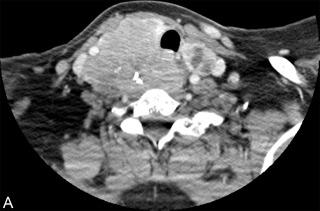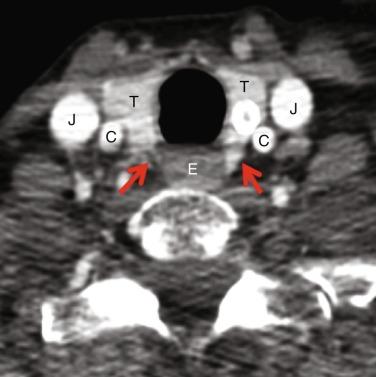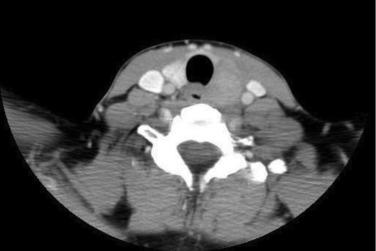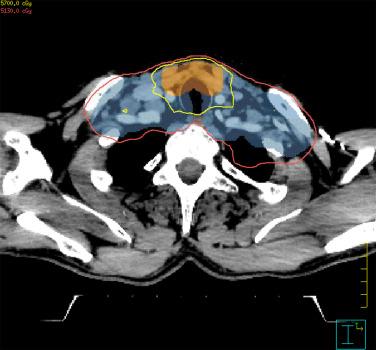Physical Address
304 North Cardinal St.
Dorchester Center, MA 02124
Surgery is, with the exception of lymphomas described in this chapter, the mainstay of therapy for all types of thyroid cancer. However, if there is an increased risk of recurrence, further additional treatment may be warranted. In differentiated thyroid cancer (DTC), also described elsewhere, this is often in the form of radioactive iodine. However, in DTC, if the risk of locoregional recurrence is high and it is determined that radioactive iodine will be insufficient to minimize the risk of such recurrence, there is a potential role for external beam radiotherapy (EBRT), akin to a situation with surgically unresectable disease. Similarly, in both anaplastic thyroid cancer (ATC) and medullary thyroid cancer (MTC), if the cancer is unresectable or if there is a high risk of locoregional recurrence, postoperative EBRT may be an important part of the patient’s management.
This chapter will describe the evidence for a role for EBRT in management of unresected and resected DTC, ATC, and MTC, as well as in the role of palliating symptoms from metastatic disease, and will describe the role of EBRT in the treatment of thyroid lymphoma. It will discuss technical aspects of delivering EBRT and its potential side effects.
One of the earliest reports on the use of EBRT in DTC comes from the 1960s and reported that just over 50% of patients with unresected tumor had long-term control of the disease in the neck. Much more recently, our group reported a 90% local relapse-free rate at 10 years in 40 patients with gross residual disease after surgery. However the 10-year cause-specific survival was 48%; a lower rate of survival was observed because of the number of patients who went on to have distant metastases. Another important series with a large sample size consists of 217 patients with post surgical residual disease from Hong Kong. In the 70% of patients who had EBRT, the 10-year local control rate was 64% compared with only 24% who did not receive EBRT. The cause-specific survival at 10 years was 74% with EBRT and 50% without EBRT. Both differences were statistically significant. As in all the retrospective reports discussed in this chapter, concern however, about potential biases, especially case selection, must be acknowledged. There are other small series that also show a benefit to EBRT in controlling neck disease. For instance, the Christie Hospital group in Manchester, U.K., reported local control rates of 69%, and the MD Anderson Cancer Center group in Houston, U.S., reported a 60% local control rate.
Given how devastating uncontrolled disease in the neck can be, it is important all patients who have unresectable DTC be considered for EBRT. For patients who have had a thyroidectomy, we consider giving radioactive iodine (RAI) before EBRT, as there is a theoretical risk of blunting the uptake of RAI if EBRT is given first. However, if because of the local extent of disease, thyroidectomy is not performed, we proceed with EBRT. It is important to ensure the airway is sufficiently patent for EBRT, including accounting for possible swelling from EBRT. If there is a risk of obstruction, a tracheotomy should be discussed, and if required, inserted before simulation for EBRT. Our usual practice is to give 66 Gy in 33 fractions over 6.5 weeks or, as in the case in Figure 49.1 , in a patient with small-volume lung metastases, 50 Gy in 20 fractions. If the patient’s performance status is poor, upfront palliative radiotherapy may be considered to protect the airway. The recent American Head and Neck Society guidelines endorsed the value of EBRT in gross residual disease and recommend EBRT for patients with gross residual or unresectable locoregional disease, except for patients less than 45 years old with limited gross disease that is radioactive iodine-avid.

It is well recognized that age and extrathyroid extension are two of the most import prognostic features for local recurrence in thyroid cancer. The American Joint Committee on Cancer (AJCC) and International Union Against Cancer (UICC) 8th edition of the tumor, node, metastases (TNM) classification of cancer have recently recognized that both the extent of local invasion and the age cutoff at which the risk of recurrence increases needed to be revised. In the 8th edition of the TNM, the respective age cutoff and definitions of high-risk extrathyroid extension were changed. The age cutoff for defining a poor prognostic group was increased to 55 years of age having previously been 45. The definition of T3 was changed so that minimal extrathyroid extension is no longer a definition for T3 and that only gross extrathyroid extension is recognized. T3a is reserved for lesions with a largest diameter over 4cm and T3b for gross strap muscle invasion. T4a disease is defined as (tumor extends beyond the thyroid capsule and invades any of the following: subcutaneous soft tissues, larynx, trachea, esophagus, recurrent laryngeal nerve) and T4b disease (tumor invades prevertebral fascia, mediastinal vessels, or encases carotid artery). T4b disease is invariably unresectable and benefits from radiotherapy ( Figure 49.2 ). It is these older patients with gross extrathyroid extension who are at risk of recurrence after surgery and may benefit from EBRT ( Table 49.1 , Figure 49.3 ).

| Disease Extent | Stage | Radiotherapy | Exception |
|---|---|---|---|
| Unresectable or gross residual | T4b | High dose radical radiotherapy and RAI if thyroidectomy performed | Young patients with small-volume residual disease and RAI uptake in the thyroid bed |
| Gross extrathyroid extension Microscopic residual |
T4b | High dose radical radiotherapy and RAI | Consider even in patients < 55 years old |
| Gross extrathyroid extension Microscopic residual (see Figure 49.3 ) |
T4a | High dose radical radiotherapy and RAI | Young patients < 55 years old |
| Gross extrathyroid extension No residual disease, negative margins |
T4a | RAI only radiotherapy not required |
Older patients ≥ 55 with tall cell or insular changes may benefit |
| Minimal extrathyroid extension and positive margins | T1-3 | RAI only radiotherapy not required |
Older patients with tall cell or insular changes may benefit |
| Recurrent nodal disease after surgery and repeated RAI or extracapsular nodal disease with positive margins (see Figure 49.4 ) | N1b | Adjuvant radiation |

Although the evidence for a role of EBRT in the management of unresectable DTC is well established, the role in the adjuvant management after the resection of all gross disease is more controversial. There have been numerous single institution retrospective studies that indicate improved outcome after EBRT in high-risk DTC; these are summarized in Table 49.2 . Most of these studies are flawed due to uncertain case selection biases and inconsistent use of RAI. In the study of Farahati et al., probably the study with the most consistent case selection and treatment, all patients were treated with RAI and all were defined as high risk in that they were all over the age of 40 and all had extrathyroidal extension. They report that there was a reduction in local and regional recurrences in 85 patients who had EBRT and RAI compared with 52 patients who only had RAI. Our own study defined high-risk patients as those over 60 who had extrathyroidal extension but no gross residual disease after surgical resection. We reported an overall 10-year local control rate of 86.4% after EBRT compared with 65.7% if no EBRT was given. There was also a small but significant improved local control rate (95.9% versus 85.4%, p = 0.03) but not an improved rate of survival in patients between the ages of 45 and 60 years. More recent single institutional studies have not compared patients treated with and without EBRT but have reported the local control rate in patients considered at high risk of recurrence. For example the MD Anderson group reported a regional local control rate of 86% and 82% cause-specific survival at 4 years in patients with microscopic residual disease after resection.
Ideally, to prove a role for EBRT, a randomized controlled study should be performed, but unfortunately there has not been one due to the difficulty in recruiting sufficient patient numbers and the length of follow-up required. One was attempted in Europe, but it failed to recruit and was closed. In our opinion, it was flawed as patients we would consider to be low risk of local relapse (young patients and patients with only minimal extra thyroid extension) were included.
In a systematic review, 16 articles were thought to be appropriate after a comprehensive literature review of the role of EBRT that initially identified 821 articles. This resulted in a pooled population of 5114 patients. There were no randomized studies and only one prospective study identified. In the 13 studies that reported local regional recurrence, the recurrence rate was 20% without EBRT and 13% with EBRT. The authors concluded that there was an improvement in locoregional control after EBRT in high-risk patients over 45. In another report, which reviewed the English and French literature on the role of EBRT in DTC, French authors proposed a scoring system that they acknowledged requires validation. In this system, various prognostic factors are assigned a score. For instance, less than 45 years of age is 0 points, 45 to 60 years is 1 point, and greater than 60 years is 2 points. They conclude any patient with a score of 6 or more should be recommended EBRT. For example a patient over 60 (2 points), with extrathyroid extension (2 points) and microscopic residual (2 points) scores 6 points and would be recommended EBRT.
In a study of patients in the U.S. National Cancer Database (NCDB) with stage IV DTC and who had primary surgical treatment between 2002 and 2012 in a multivariate analysis, the addition of RAI to surgery significantly improved 5- and 10-year survivals in stages IVA, IVB, and IVC. EBRT was associated, however, with a higher mortality and in Stage IVB (T4b, any N, M0), this was statistically significant. However, the authors conclude that the clinical indications to treat with EBRT were associated with poorer survival and that it would be a misinterpretation of the data to conclude that EBRT treatment resulted in the poorer survival.
Although the American Head and Neck Society has stated that after complete resection EBRT may be considered in select patients greater than 45 years old with a high likelihood of microscopic residual disease and a low likelihood of responding to RAI, it may be that a higher age cutoff of 55 would be more appropriate. The 2009 American Thyroid Association (ATA) guidelines recommend that EBRT should be considered in patients over age 45 with grossly visible extrathyroidal extension at the time of surgery and a high likelihood of postoperative microscopic residual disease. The authors also state that although after complete resection, cervical lymph node involvement alone should not be an indication for EBRT, EBRT may be considered if there is extensive extracapsular spread with high risk of microscopic residual disease ( Figure 49.4 ). The more recent 2015 ATA guideline does not address the situation of adjuvant radiotherapy but comments that for tumors that invade the upper aerodigestive tract, surgery combined with additional therapy such as 131 I and/or EBRT is generally advised. The U.K. guidelines recommended in addition to RAI that EBRT should be considered in unresectable tumors and when there is residual disease after surgery, even if the residual disease concentrated RAI.

All patients having high doses of EBRT should have treatment with modern radiotherapy techniques such as intensity-modulated radiotherapy (IMRT) or a variation of IMRT such as volumetric-modulated arc therapy (VMAT). IMRT has been shown to reduce toxicity and in some cases improve disease control in head and neck cancers although data does not exist specifically for thyroid cancer patients. In our institution, 60 Gy in 30 fractions is usually prescribed to the thyroid bed and areas of surgical dissection, and a lower dose of 54 Gy in 30 fractions to undissected areas at risk of microscopic disease (see Figure 49.4 ). In patients with gross residual disease, a higher dose of 66 to 70 Gy in 33 to 35 fractions is given to the disease with 56 Gy in 33 fractions to the areas at risk of microscopic disease. The volume to be treated in this setting is controversial, and one must balance the risk of microscopic disease versus the risk of toxicity. The volume we treat in our institution is usually the surgical thyroidectomy bed and levels III, IV, VI, and part of level V. The volumes typically extend from the hyoid bone superiorly to the aortic arch inferiorly but are adjusted depending on the clinical findings. It is important before proceeding with any EBRT to have a discussion with the patient and the surgeon to confirm the high risk of locoregional recurrence and in determining the anatomic volume of tissues at high risk. If possible, the placement of markers such as surgical clips in the areas of greatest concern at the time of surgery can aid in delineating the boost volumes for EBRT. In addition, ensuring there is a computed tomography (CT) scan of the extent of disease before surgery is important to allow this to be fused to the postsurgical CT simulation to aid in delineation.
Become a Clinical Tree membership for Full access and enjoy Unlimited articles
If you are a member. Log in here